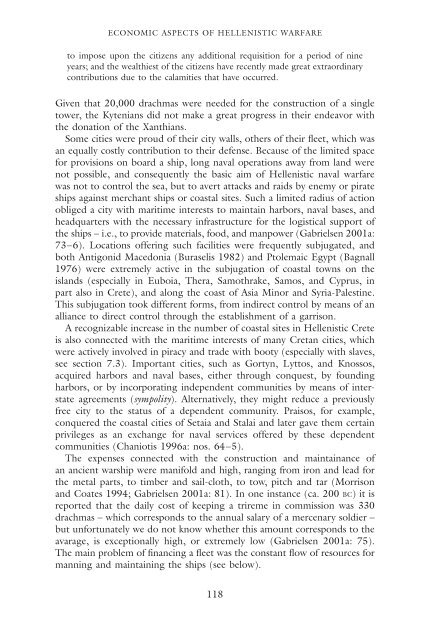WAR IN THE HELLENISTIC WORLD
WAR IN THE HELLENISTIC WORLD
WAR IN THE HELLENISTIC WORLD
Create successful ePaper yourself
Turn your PDF publications into a flip-book with our unique Google optimized e-Paper software.
ECONOMIC ASPECTS OF <strong>HELLENISTIC</strong> <strong>WAR</strong>FARE<br />
to impose upon the citizens any additional requisition for a period of nine<br />
years; and the wealthiest of the citizens have recently made great extraordinary<br />
contributions due to the calamities that have occurred.<br />
Given that 20,000 drachmas were needed for the construction of a single<br />
tower, the Kytenians did not make a great progress in their endeavor with<br />
the donation of the Xanthians.<br />
Some cities were proud of their city walls, others of their fleet, which was<br />
an equally costly contribution to their defense. Because of the limited space<br />
for provisions on board a ship, long naval operations away from land were<br />
not possible, and consequently the basic aim of Hellenistic naval warfare<br />
was not to control the sea, but to avert attacks and raids by enemy or pirate<br />
ships against merchant ships or coastal sites. Such a limited radius of action<br />
obliged a city with maritime interests to maintain harbors, naval bases, and<br />
headquarters with the necessary infrastructure for the logistical support of<br />
the ships – i.e., to provide materials, food, and manpower (Gabrielsen 2001a:<br />
73–6). Locations offering such facilities were frequently subjugated, and<br />
both Antigonid Macedonia (Buraselis 1982) and Ptolemaic Egypt (Bagnall<br />
1976) were extremely active in the subjugation of coastal towns on the<br />
islands (especially in Euboia, Thera, Samothrake, Samos, and Cyprus, in<br />
part also in Crete), and along the coast of Asia Minor and Syria-Palestine.<br />
This subjugation took different forms, from indirect control by means of an<br />
alliance to direct control through the establishment of a garrison.<br />
A recognizable increase in the number of coastal sites in Hellenistic Crete<br />
is also connected with the maritime interests of many Cretan cities, which<br />
were actively involved in piracy and trade with booty (especially with slaves,<br />
see section 7.3). Important cities, such as Gortyn, Lyttos, and Knossos,<br />
acquired harbors and naval bases, either through conquest, by founding<br />
harbors, or by incorporating independent communities by means of interstate<br />
agreements (sympolity). Alternatively, they might reduce a previously<br />
free city to the status of a dependent community. Praisos, for example,<br />
conquered the coastal cities of Setaia and Stalai and later gave them certain<br />
privileges as an exchange for naval services offered by these dependent<br />
communities (Chaniotis 1996a: nos. 64–5).<br />
The expenses connected with the construction and maintainance of<br />
an ancient warship were manifold and high, ranging from iron and lead for<br />
the metal parts, to timber and sail-cloth, to tow, pitch and tar (Morrison<br />
and Coates 1994; Gabrielsen 2001a: 81). In one instance (ca. 200 BC) it is<br />
reported that the daily cost of keeping a trireme in commission was 330<br />
drachmas – which corresponds to the annual salary of a mercenary soldier –<br />
but unfortunately we do not know whether this amount corresponds to the<br />
avarage, is exceptionally high, or extremely low (Gabrielsen 2001a: 75).<br />
The main problem of financing a fleet was the constant flow of resources for<br />
manning and maintaining the ships (see below).<br />
118
















